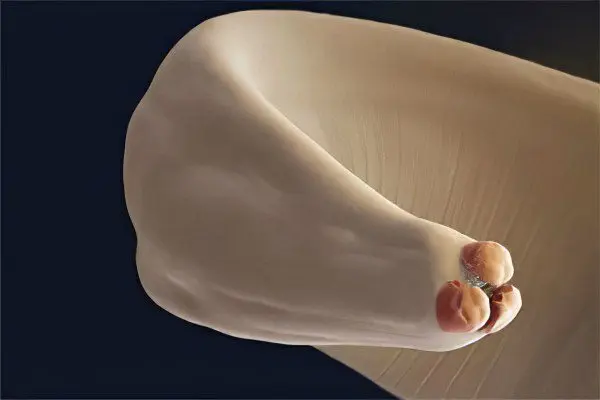
Ascaris is a round worm-parasite that lives in the small intestine of a person and provokes the development of a disease such as ascariasis in him. The life cycle of the parasite is quite complex, although it does not require multiple hosts. The worm can only live in the human body.
Despite the complex process of development of a worm from a laid egg, ascariasis is distributed throughout the world. According to the WHO, the average number of infected is approaching 1 billion people. Ascaris eggs cannot be found only in permafrost zones and in dry deserts.
The scheme of development of the roundworm life cycle is as follows:
After fertilization, roundworm eggs are released into the external environment along with feces. After a certain time, they fall into the soil, where they begin to ripen. In order for eggs to be able to be invaded by humans, three conditions will need to be met: high soil moisture (roundworms prefer silty, clay and chernozem soils), its good aeration and high ambient temperature. In the soil, eggs retain their potential for a long time. There is evidence that they can remain viable for 7 years. So, if all the conditions are met, then after 14 days in the soil, ascaris eggs will be ready for human invasion.
The next stage is called the larval stage. The fact is that immediately after maturation, the larva cannot infect a person, it needs to go through the process of molting. Before molting, the egg contains a larva of the first age, and after molting, a larva of the second age. In general, in the process of migration, roundworm larvae make 4 molts.
When an infective larva, surrounded by protective shells, enters the human gastrointestinal tract, it needs to get rid of them. The destruction of the egg shell occurs in the duodenum. In order for the protective layer to dissolve, a high concentration of carbon dioxide, an environmental acidity of pH 7 and a temperature of +37 degrees Celsius will be required. If all these three conditions are met, then a microscopic larva will hatch from the egg. Its size is so small that it seeps through the intestinal mucosa without any difficulty and enters the bloodstream.
The larvae penetrate the venous vessels, then, with the blood flow, they go to the portal vein, to the right atrium, to the ventricle of the heart, and then to the capillary network of the lungs. Until the moment when the larvae of ascaris penetrate from the intestine into the pulmonary capillaries, an average of three days pass. Sometimes some of the larvae can linger in the heart, in the liver and in other organs.
From the capillaries of the lungs, the larvae enter the alveoli, which make up the lung tissue. It is there that there are the most favorable conditions for their further development. In the alveoli, the larvae can linger for 8-10 days. During this period, they go through two more molts, the first on the 5th or 6th day, and the second on the 10th day.
Through the wall of the alveoli, the larva penetrates into the bronchioles, into the bronchi and into the trachea. The cilia, which thickly line the trachea, lift the larvae up into the larynx with their shimmering movements. In parallel, the patient has a cough reflex, which contributes to their throwing into the oral cavity. There, the larvae are again swallowed along with saliva and again enter the stomach, and then into the intestines.
From this point in the life cycle, the formation of a full-fledged adult begins. Doctors call this phase the intestinal phase. The larvae re-entering the intestine are too large to pass through its pores. In addition, they already have sufficient mobility to be able to stay in it, resisting fecal masses. Turn into an adult ascaris after 2-3 months. It has been established that the first clutch of eggs will appear in 75-100 days after the egg enters the human body.
In order for fertilization to occur, both the male and the female must be in the intestine. After the female lays ready-made eggs, they, along with feces, will come out, fall into the soil and wait for the optimal moment for the next invasion. When this happens, the worm’s life cycle will repeat itself.

As a rule, it is according to this scheme that the life cycle of roundworms occurs. However, atypical cycles of their life are described. This means that the intestinal phase does not always replace the migratory one. Sometimes the larvae can settle in the liver and die there. In addition, during an intense cough, a large number of larvae come out with mucus into the external environment. And before reaching puberty, they die.
It is worth noting that some Ascaris larvae can exist in other organs for a long time, causing characteristic symptoms. Ascariasis of the heart, lungs, brain and liver is very dangerous not only for health, but also for human life. Indeed, in the process of migration, even without settling in the organs, the larvae provoke the appearance of inflammatory infiltrates and micronecrosis zones in the liver and lungs. It is easy to imagine what will happen to the life-supporting organs of a person if a worm settles in them.
Parasitization of ascaris in the intestine causes immunosuppression, which negatively affects the course of other infectious diseases. As a result, a person gets sick longer and more often.
An adult roundworm lives in the intestines for about a year, after which it dies of old age. Therefore, if re-infection has not occurred in a year, then ascariasis will self-destruct.









